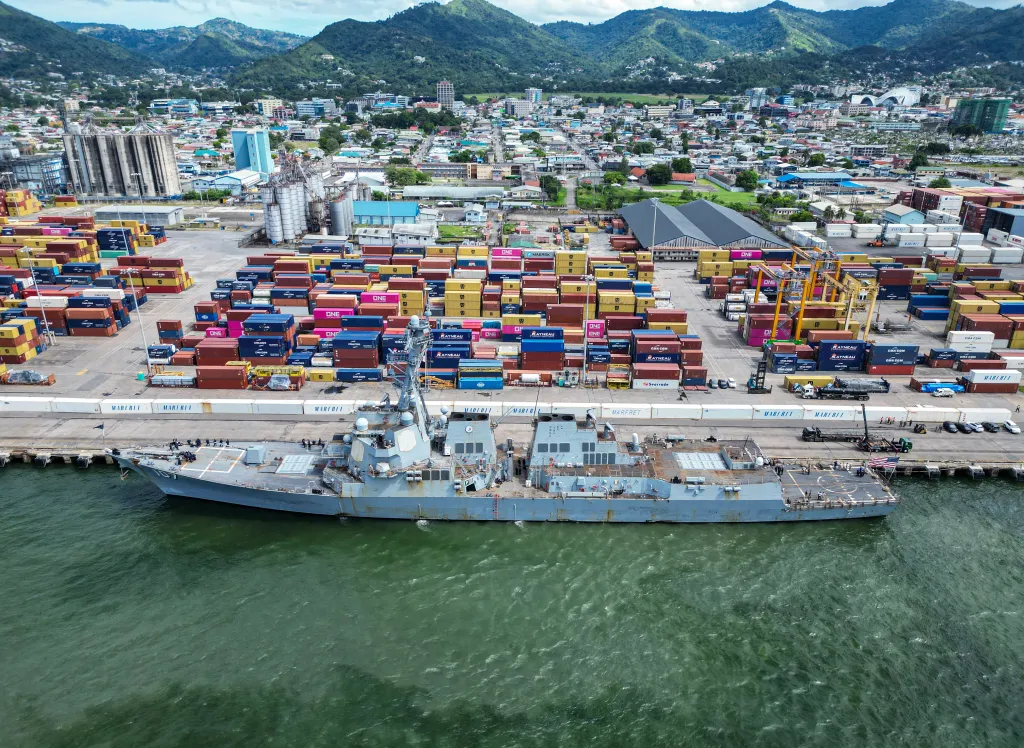Several Navy warships assigned to the Caribbean counter-narcotics mission have moved to avoid Hurricane Melissa, a U.S. Navy official told us. Now a massive Category 5 hurricane, Melissa is expected to make landfall in Jamaica later today into tomorrow with likely devastating effects. Meanwhile, it appears that the U.S. Air Force is sending another flight of B-1B bombers toward the region amid an ongoing U.S. military buildup.
“Based on current weather information and forecast models, the Navy is continuing to make determinations regarding Hurricane Melissa,” the official told us. “The safety of our personnel and their families is our top priority.” The storm is on a northeasterly track heading away from the Caribbean.
Despite the ship movements, the hurricane is “not expected to impact operations in the Caribbean,” the Navy official told us, adding that many of the eight surface vessels assigned to the effort were already operating out of the storm’s path.
The U.S. naval presence in the region includes the Iwo Jima Amphibious Readiness Group (ARG)/22nd Marine Expeditionary Unit (MEU), with more than 4,500 sailors and Marines on three ships: The Wasp class amphibious assault ship, the USS Iwo Jima, and the San Antonio class amphibious transport dock ship USS San Antonio. Also deployed in the region are three Arleigh Burke class guided missile destroyers; USS Jason Dunham, USS Stockdale and USS Gravely, the Ticonderoga class guided missile cruiser USS Lake Erie and the Freedom class littoral combat ship USS Wichita.
While the Navy official would not comment about the specific locations of most of the vessels, they did acknowledge that the Gravely is docked in Trinidad and Tobago on a previously scheduled deployment. The destroyer arrived in Port of Spain to conduct joint military training exercises with the Caribbean nation, Fox News noted. It is expected to remain until Thursday, according to government officials from the two countries.
The exercises involving the Gravely seek to “address shared threats like transnational crime and build resilience through training, humanitarian missions, and security efforts,” U.S. Embassy Chargé d’Affaires Jenifer Neidhart de Ortiz said in a statement.
The deployment of the Gravely to Port of Spain comes as the U.S. is ratcheting up the pressure on the South American nation’s dictator, Nicolas Maduro.
Venezuelan officials, meanwhile, decried the deployment of the Gravely so close to its shores. Port of Spain is located less than 25 miles from the Venezuelan coast.
The conduct of military exercises in the waters of a neighboring country is “dangerous” and a “serious threat” to the Caribbean region, the Venezuelan Foreign Ministry said, adding that it is a “hostile provocation” toward the South American nation.
Though the U.S. buildup is ostensibly aimed at curtailing drug trafficking out of Venezuela, the Trump administration has made no secret that it is pressuring Maduro, indicted in the U.S. on drug charges with a $50 million reward on his head.
As we reported last week, in addition to its assets already in the region, the U.S. Navy’s supercarrier USS Gerald R. Ford and at least a portion of the rest of its strike group have been ordered to Latin American waters. Strikes on alleged drug-smuggling boats have now become routine, and the possibility that the campaign could extend to targets on land, particularly in Venezuela, continues to grow.
“In support of the President’s [Donald Trump] directive to dismantle Transnational Criminal Organizations (TCOs) and counter narco-terrorism in defense of the Homeland, the Secretary of War [Pete Hegseth] has directed the Gerald R. Ford Carrier Strike Group and embarked carrier air wing to the U.S. Southern Command (USSOUTHCOM) area of responsibility (AOR),” Pentagon spokesman Sean Parnell said in a statement on Friday. “The enhanced U.S. force presence in the USSOUTHCOM AOR will bolster U.S. capacity to detect, monitor, and disrupt illicit actors and activities that compromise the safety and prosperity of the United States homeland and our security in the Western Hemisphere. These forces will enhance and augment existing capabilities to disrupt narcotics trafficking and degrade and dismantle TCOs.”
In addition to U.S. Navy assets, the U.S. Air Force is also contributing to the counter-narcotics effort.
For the second time in less than a week, it appears that B-1 bombers are headed to the Caribbean. Online flight trackers report that two Lancers took off from Grand Forks Air Force Base in North Dakota. Shortly after 1:45 p.m., the Lancers were located south of Puerto Rico on a path toward Venezuela.
We reached out to U.S. Global Strike Command for more information and they referred us to the Pentagon.
Regardless, as TWZ noted following B-52 sorties over the region two weeks ago, there is a well-established precedent for employing Air Force bombers in counter-narcotics operations in the Caribbean. The range and targeting capabilities that the B-52 and the B-1 possess can be and have been employed to help spot and track suspected drug smuggling vessels. However, nothing we have seen so far indicates that these bombers are taking part in drug interdiction efforts and are more likely being sent toward Venezuela in a political message to Maduro.
Amid these military movements, a key supporter of Trump suggested that Maduro should flee the country.
“If I was Maduro, I’d head to Russia or China right now,” U.S. Sen. Rick Scott (R-Florida) told the CBS News program 60 Minutes on Sunday. “His days are numbered. Something’s gonna happen. Whether it’s internal or external, I think something’s gonna happen.”
It remains publicly unclear at the moment what, if any action, the U.S. will take against Maduro. The Ford and elements of its carrier strike group is not expected to arrive in the Caribbean for about two weeks. Regardless of the timing of the Ford‘s arrival, it does not appear that Hurricane Melissa, despite its ferocity, will be a factor in the Pentagon’s plans.
Contact the author: howard@thewarzone.com
